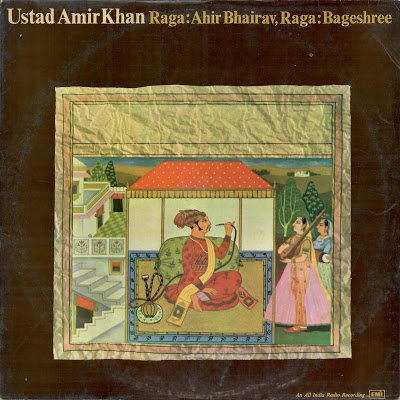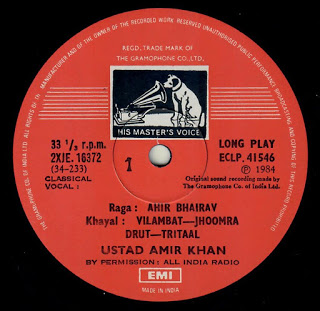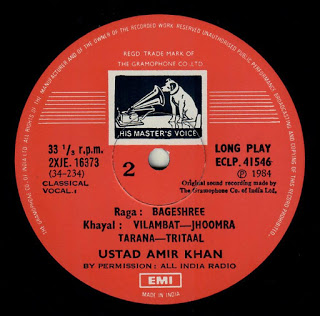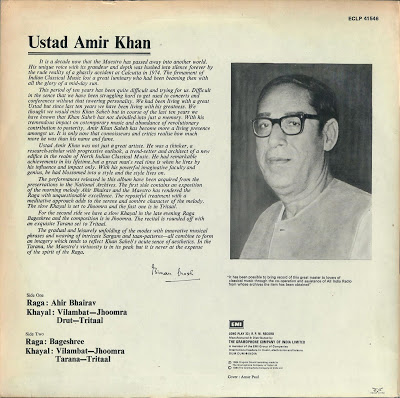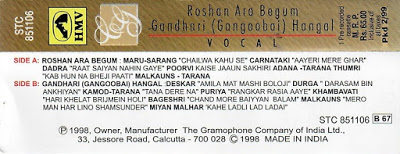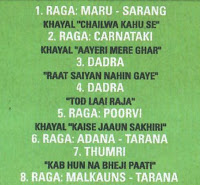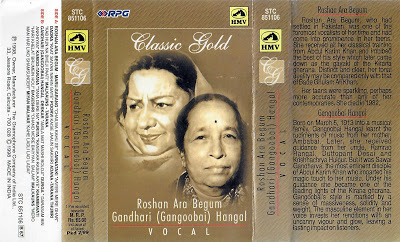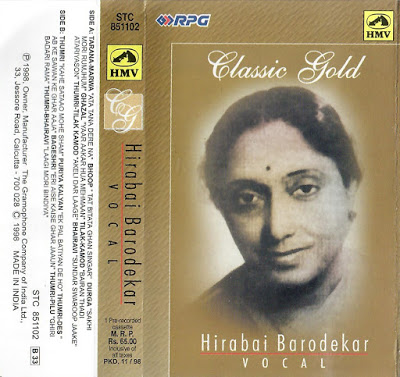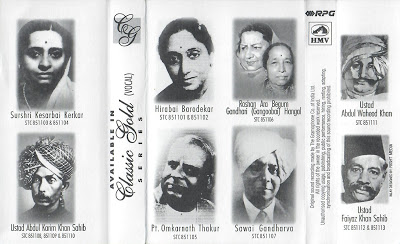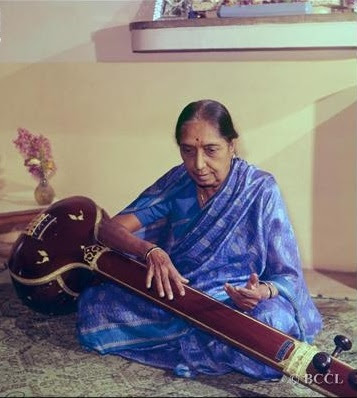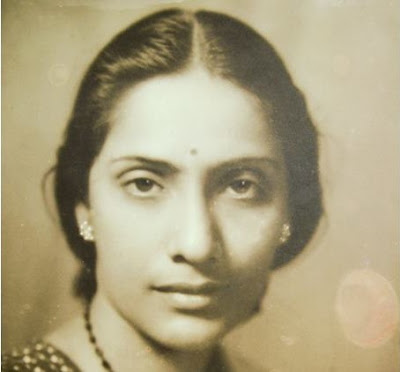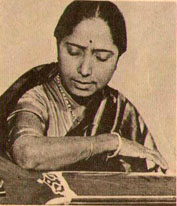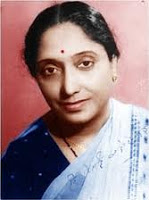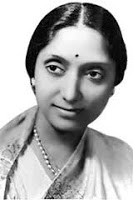Here an LP with two other very beautiful recordings from the archives of All India Radio.
Sunday, 23 December 2018
Friday, 21 December 2018
Ustad Amir Khan - Great Master Great Music - LP released in India in 1976
After the untimely death of Ustad Amir Khan many LPs and later also cassettes and CDs with recordings from the archives of All India Radio or concert recordings saw the day. Here a very beautiful one from AIR.
Ustad Amir Khan recorded onyl three studio LPs. The other two ones (1968 & 1970) we might post in the future.
Wednesday, 19 December 2018
Ustad Ameer (Amir) Khan (1912-1974) - Raga Marwa & Raga Darbari Kanada - LP released in India in 1960
We start now to post a number of recordings by the great Ustad Amir Khan. Here his very first LP, the third LP of classical Indian music released by the Gramophone Company of India.
I bought it in the first half of the 1970s in the HMV shop on Oxford Street in London. I never had seen before so many LPs from India. I spend all my money there. If I remember correctly I bought about 20 LPs. Many of them vocal music by artists I only had read about till then and saw there for the first time LPs by them. Only the following year I made it to Southall, a small town next to London with a mostly Indian and Pakistani population. In Southall there were 3 or 4 Indian-Pakistani record shops and that was then even more paradise for a collector.
On the artist see the two articles below and these links:
From: Great Masters of Hindustani Music by Susheela Misra.
Ustad Amir Khan by Susheela Misra
Fourteenth February 1974 was an ill-fated day for Hindustani music because it lost two great stalwarts on the same day. Pt. Srikrishna Narayan Ratanjankar succumbed to protracted illness. Ustad Amir Khan in the height of his form and fame, was tragically killed in a car accident. Although in his early sixties the Ustad was still a force to reckon with in North Indian music, and had it not been for that grievous accident, he might have easily gone on dominating the music world for another decade or so. The world of Indian music went into mourning on l3th February 1974, and there were public condolence-meetings in numerous cities. Programmes of tributes to the two departed maestros were broadcast from all the important Stations of All India Radio.
Born in April 1912 in Kalanaur, Amir Khan began his musical training as a Sarangi- disciple of his own father Ustad Shahmir Khan, a noted Sarangi player who had learnt his art from Chajju Khan and Nazir Khan of the Bhindibazar gharana. Amir Khan’s early grooming in Sarangi was only the foundation of his musical edifice. He had a vision and imagination of his own for higher artistic flights. Being a reputed artiste and a warm friendly person, Shahmir Khan’s hospitable home was a veritable rendezvous of many great contemporary maestros like Ustads Allabande Khan, Jafruddin, Nasiruddin Khan, Beenkar Wahid Khan, Rajab Ali Khan, Hafeez Khan, Sarangi- nawaz Bundu Khan, Beenkar Murad Khan and several others. Thus, although Amir Khans’s early musical training commenced with Sarangi, the impressionable and intelligent youngster was constantly exposed to the various vocal gharanas of the times. Gradually, Shahmir Khan himself began to devote more time to Amir Khan’s vocal training in which merukhand (or Khandmeru) practice and sargam-singing were specially emphasised. Moulded by the styles of three great giants of his younger days, namely, Ustads Bahre Wahid Khan, Rajab Ali Khan and Aman Ali Khan, Amir Khan evolved his own stylistic school which came to be known as “the Indore Gharana.”
In fact, Amir Khan was a self-taught musician. He assimilated the distinctive features of the gayakis that appealed to his aesthetic sense and were in perfect accord with his voice. The style that he evolved was a unique fusion of intellect and emotion, of technique and temperament, of talent and imagination. His style was a synthesis of three different styles. He assimilated the colour and spirit of Wahid Khan’s style, (with its chastity of swara intonation and a richly soporific effect of melodic elaboration) so well that Ustad Wahid Khan blessed him. “Long shall my music live in you after I am gone”. The slow Khayal is rendered in such a slow tempo that it has “the langour of unfinished sleep.” This style originated in the Merukhand style of the Bhindibazar-gharana. This generally strove to produce the permutations and combinations of a given set of notes. These are like mathematical exercises with little artistic effect in a concert. The development of the Vilambit Khayal was marked by deep serenity. The concept of an extra slow tempo with a slow and meticulous unfolding of the raga and the “cheez” was taken from Ustad Bahere Wahid Khan. His taans were clearly influenced by the eloquent ones of Ustad Rajab Ali Khan. In sargam-singing, he revealed his admiration for Ustad Aman Ali Khan. During his early sojourn in Bombay, Amir Khan had be come a close friend of Late Aman Ali Khan. Amir Khan always maintained that had Aman Ali Khan lived longer he would have been the former’s “confrere in the world of music”. This newly amalgamated “Indore” style of Ustad Amir Khan captivated and influenced a whole generation of younger musicians of all categories through the contemplative and reposeful beauty of his slow, leisurely Badhat (elaboration) enlivened by the “exuberance of his proliferating sargams” and rushing taans. So tremendous has been the impact of his distinctive “gayaki” on the rising generation of young Hindustani vocalists that Amir Khan commanded a large following among the younger aspirants. He no longer remained as an isolated individual.
For years, he remained one of the most sought after classical vocalists of his times. What set him apart from his contemporary artistes was the fact that he never made any concessions to popular tastes, but always stuck to his pure, almost puritanical, highbrow style. “His music combined the massive dignity of Dhruvpad with the ornate vividness of Khayal”. There are some musicians of the Kirana school who argue that the words of the Khayals are of no importance ! But Amir Khan held different views. He used to say: “The poetic element in Khayal is as vital as its melodic element. An artiste has to have a poet’s imagination to be a good musician”. Amir Khan has proved that “chaste refined music does not lack listener-response”, for, he strictly remained uncontaminated by the present craze for showiness. The tall, handsome Ustad had a dignified concert presence. His dignity of bearing and his posture of Yogic calm on the stage struck a perfect accord with the serene grandeur of his music. It was as though his musical thought was in tune with some ideal of beauty and he was striving to communicate it to his charmed audience”. As Prof Sushil Kumar Saxena wrote (in the Sangeet Natak Akademy Journal 31) “An Amir Khan swara was at once a tuning of the self, a calm that spreads while Ghulam Ali’s glows with a pulpy luminosity.”
Amir Khan’s forte was the exaggeratedly slow or ati vilambit Khayal which he developed in a most leisurely mood with deep serenity and contemplativeness. While his ardent admirers found this part of his concert absolutely engrossing, there were others who found it “excruciatingly slow” or even “insipid”! He always avoided Sarangi accompaniment, and wanted nothing more than a steady, plain Theka from his Tabla accompanist. His favourite slow talas were Jhoomra and Tilwada. Words were subservient to the “absolute music” that he sang, and naturally, “bol-alaps” and “Bol taans” were conspicuously absent in his singing. In the course of his prolonged unfoldment of the vilambit Khayal asthayi, Amir Khan would sometimes render flashing “meteoric taans”. His “taans” were marked by many graces like elegant gamaks, lahak and clear “daanas” (clarity of each note). It was natural that the Ustad always chose highly serious, expansive, traditional ragas like Todi, Bhairav, Lalit, Marwa, Puriya, Malkauns, Kedara, Darbari, Multani, Poorvi, Abhogi, Chandrakauns and so on. Even the lighter ragas like Hamsadhwani acquired a serious expansive mood when rendered by Amir Khan. His rich, mellow voice was at its best in the deep, dignified “mandra” notes (lower notes). His voice had some inherent limitations, but he shrewdly evolved a style to suit his voice.
Summing up the essence of his father’s vocal style, Ekram Ahmad Khan (the eldest son of the Ustad) wrote: “Amongst the elder maestros of music, Khan Saheb was intensely devoted to Rajab Ali Khan of Dewas, and Aman Ali Khan of Bhindibazar. He also studied the styles of Bahere Wahid Khan and Abdul Karim Khan and amalgamated the essence of the styles of these four maestros with his own intellectual approach to music, and conceived what is now known as the Indore gharana of music”.
During the first 25 years of his life, Amir Khan devoted considerable time to sargam- singing, what is known as “Merukhand practice” consisting of varied permutations and combinations of kaleidoscopic swara-patterns. These complicated “Khandameru” sargams, and flashing meteoric taans brightened his reposeful vilambit Khayals now and then. The ”Merukhand” style of singing is mentioned in the l4th century Sanskrit classic Sangeeta-ratnakara of Sarangdeva.
Another significant aspect of Amir Khan’s art imparting it a unique quality, was his refined voice and the way he moulded it to suit his chosen style. Endowed with the face of an intellectual, his temperament, like his music, was serene, unruffled. He never lost his temper. He extended the same courtesy to all, big and small, and listened attentively to even lesser artistes. Humility was native to him, his judgements were generous, and he was above petty jealousies.
Although Amir Khan never rendered Thumris in his concerts, his disciples speak of the exquisite way in which he rendered Thumris for them in his intimate home-circle. His “cultured” voice was suited for the melodious Thumri style also. Amir Khan’s sole concession to the speed-loving contemporary listeners was the Tarana in which he did considerable research. According to him, the Tarana-syllables have a mystical significance. Although his voice was at its best in the lower notes, it could also soar and sweep across far-off swaras with nimble grace. Such was the influence of his music that in an era of impatient listeners, Ustad Amir Khan was able to instil, by the example of his own art, a genuine and widespread love for serious, contemplative music into the hearts of young music lovers all over the country. He was strongly against the idea of any short-cuts to success in music.
Even when Amir Khan did playback singing for some films, he refused to cut adrift from his classical moorings. The songs he rendered were always in highly classical style and in ragas like Darbari, Adana, Megh, Desi, Puriya Dhanasri etc. In his tribute to the Ustad, Prof S.K. Saxena writes in the Sangeet Natak Akademi Journal: “Amir Khan was different and solitary because of his absolute indifference to the reactions of his audience while he was singing. He never seemed to make a conscious endeavour to please the audience. He faced them majestically, with his music alone, and with pure classicality. Often his music seemed strangely disembodied from raga-tala distinctions into a kind of musical incense borne aloft on the very wings of devotion. His music, at its best, was rarely a dazzle. It would be rather an influence, an atmosphere which would just be with us till long after the recital”.
There was a time when Amir Khan was a rage in Calcutta and no music conference there was complete without his recital. The Films Division of the Government of India has brought out a documentary film on his life in recognition of his great contribution to Hindustani music. For his eminence as a performing artiste and for his significant contributions to classical music, he was crowned with many honours such as the Fellowship of the Sangeet Natak Akademi, the Presidential Award, Padma Bhushan (1971) and the Swar Vilas from Sur Singar Samsad (1971). But these honours and his large following in the music world left him untouched. Amir Khan continued to be a very simple individual “accessible to all and sundry”, and he never assumed any airs like some of his contemporaries. Though not educated in the formal sense, he was a highly sophisticated person who moved with dignity in the highest society where he was genuinely revered. It was considered a privilege to be his friend. Through his own efforts, he learnt Hindi, Urdu, Persian and a bit of Sanskrit, and he studied the writings of Guru Nanak, Vivekananda, Ramakrishna Paramahamsa and others. Khan Saheb’s son Ekram Ahmad Khan writes that it was these studies and his close friendship with Narayan Swami (of Calcutta) that led to his unique blend of Sufism. “Khan Saheb”, writes his son, “was a Sufi in the true sense of the word - a man without any specific religious ties, a man totally devoted to the oneness of mankind, a true citizen of the World”. Amir Khan was a good composer and some of his compositions reflect these religious convictions of his. One instance is “Laaj rakh lijyo mori, Saheb, Sattar, Nirankar, Jai ke Daata, Tu Raheem Ram Teri maaya aparampar, Mohe tore karam pe aadhar Jag ke daata.” Whenever I heard Amir Khan singing the Khayal in Bairagi beginning with the words “Man sumirat nis din tumharo naam”, I felt that the words and the spirit of the raga were most aptly suited for Amir Khan’s musical temperament.
Since 1968, Khan Saheb used to go to U.S.A in alternate years to spend the summer with his son Ekram Ahmad Khan, a graduate in chemical engineering from McGill University who has settled down in U.S.A as an Engineering Manager in Canada. [Sounds odd, doesn’t it? Maybe he lives in Buffalo and drives to Toronto for work:-). I wonder where Ekram is today and if he has any private unissued recordings of the Khansaheb – RP] Amir Khan also used to go as a visiting professor of music at the State University of New York at New Paltz where “he planted not only the seeds of his music among the students, but also left behind the legacy of his Sufi philosophy”.
Unassuming in his ways, Amir Khan had the capacity to adjust himself perfectly to his environments. He seemed equally at home among the humble as well as among the highly sophisticated. What a pity that this great artiste was snatched away in the peak of his career! Here was a rare classicist who sustained his art by pure devotion, and yet enjoyed wide popularity. Even now, more than 7 years after his untimely death, Amir Khan’s music is still a living force because his voice is being frequently heard over AIR through his recordings in the Archives and his Long Playing Records. The Indore gharana of Amir Khan continues to live on through his pupils like Amarnath, Kanan, Srikant Bakre, Singh Brothers, Kankana Banerji, Poorabi Mukherji and others. There are many others whose singing has been obviously coloured by the style of Amir Khan. The singer is gone, but his music is still with us.
*****
USTAD AMIR KHAN by G.N. Joshi
The death of Ustad Amir Khan in a tragic motor accident in Calcutta a few years ago has created a void in the world of Hindustani classical music. At the present time, when there is a dearth of such gifted artists, his death is an irreparable loss. Had he lived longer he would have had, at least, a number of able and talented disciples to carry on the tradition of his gharana.
In the last 25 years some artists have, by their revolutionary spirit, progressive outlook and creative faculties brought about radical changes in the style of presentation of classical music. Ustad Amir Khan was such an artist. Like Kumar Gandharva. Amir Khan disregarded the age-old, conventional traditions, and with his intelligence and talent evolved an entirely original style of presentation. He also succeeded in gaining the approval and recognition of critics and connoisseurs.
Amir Khan was born at Indore in 1912. Music was in his blood; his ancestors had been musicians in the Mughal courts. His father was an expert sarangi and veena player. A mehfil of Amir Khan’s was always a pleasant experience. He had a very impressive and magnetic personality. At his concerts he would always sit in the posture of a yogi doing his tapasya, with closed eyes and deep meditation. He maintained the same position till the end of his concert. His smiling countenance, a total lack of gesticulation or facial distortion, his absolute concentration on the song, and the slow, gradual build-up of a raga picture invariably kept his audience completely engrossed. He had, for accompaniment, two tanpuras tuned to perfection, a subdued harmonium and a tabla with a straight, simple but steady laya. An atmosphere of solemnity and tranquillity pervaded his concerts, in striking contrast with the noisy and sometimes unmusical gymnastic bouts some singers have with the tabla players that entertain listeners with acrobatics rather than providing them with aesthetic delight.
He had cultivated his voice till it was as exquisitely chiselled as a piece of sculpture. While presenting a raga he unfolded it with extreme skill, delicacy and purity. At times, when an ascending note appeared to be suspended in mid-air, he unexpectedly made a lightning play on that note, holding the audience spellbound. Because of his inborn, instinctive knowledge of avakash, kal and laya he was able to make his voice sound as if he was singing swaras from two different octaves simultaneously, treating his audience to a unique celestial experience. His mastery over layakari and the swaras was complete. His taans though complicated, and full of artistic twists, were executed in an easy and graceful way. He had an amazingly wide range of pitch, and he moved majestically through this span with his liquid golden voice. Listeners were always favourably impressed by his gayaki and skilled display of tonal beauty. He did not agree with the popular notion that the tarana was just a tongue-twisting exercise with a meaningless cluster of words, involving a lot of vocal jugglery in an ever-increasing tempo. He always put into a tarana a Persian couplet interwoven in the apparently meaningless ‘Dir tun, tan, din yalali, yalallum’, and honestly believed that these syllables did have some mysterious and mystic import. According to him it was the Persian scholar Amir Khusro who invented the tarana. Amir Khan was very keen on establishing this theory by carrying out research to unravel the hidden meanings of the tarana. But cruel destiny snatched him away and his mission was left unaccomplished.
Amir Khan’s presentation was always thoughtful and methodical and he rarely indulged in repetitive phrases. The thorough treatment he gave each raga naturally required considerable time for flawless elaboration. It was well-nigh impossible to get a satisfactory exposition from him in just 3 minutes. It was therefore only in the late 1960s that I could have him to record for a long-playing disc (in effect, it must have been in the late 1950s and the recordings in question are the ones we post here on his very first LP). It was not an easy job to bring him before the mike, though obtaining his consent was not all that difficult. Even to approach him posed a very big problem for me. Amir Khan lived, in those days, in very disreputable surroundings, where it was considered very objectionable for any gentleman to go, even during the day. This is the locality a little beyond and opposite the Congress House on Vallabhhhai Patel Road, near the Kennedy bridge. It is inhabited by professional singing and dancing girls, as well as prostitutes. Amir Khan was giving tuitions to some of these singing girls for his living and therefore had to stay in one of the buildings on the third floor. Later, when his financial position improved, he shifted to a flat on Peddar Road. Just beyond the building where Amir Khan lived was the residence of an elderly singer by the name of Gangabai. Ustad Bade Gulam Ali Khan and Ahmad Jan Tirakhwa often stayed with her. This shows that even women of these professions were treated with respect as artists, in artistic cirles. As the recording executive of H.M.V. I had to contact artists regardless of time and place.
To obtain Amir Khan’s agreement for the recording I had to meet him, and, therefore it was incumbent on me to visit his residence. I was greatly put off when I learnt about the locality where he stayed. I was afraid of what people would say if they observed me entering a house of ill repute. Any outsider would naturally draw his own conclusions, not knowing that an eminent singer was living in that building. If I had, out of fear of social stigma, refrained from going to visit Amir Khan, his great artistry would have gone unrecorded. The idea of securing his consent for recording together with a keen sense of duty prompted me to enter the building, eyes downcast, not looking about me till I entered Amir Khan’s room on the 3rd floor. Once in his room I cheered up, and I talked to him for an hour or two. After that I visited him often. We exchanged views on music and gharanas, and such visits gave me opportunities to study his likes and dislikes. These visits also gave him confidence in me. After a couple of months and 4 or 5 such visits, he agreed to come for a recording. Some more time was lost in persuading him to agree to the terms of payment. Finally this hurdle too was crossed. Yet Amir Khan went on cancelling dates, giving fresh ones and then again postponing the recording on some flimsy ground. I got fed up with his dilly-dallying and, in spite of my great regard and respect for him, I justifiably felt very annoyed. Ultimately one day I plucked up my courage and said to him, ‘If I had approached God Almighty as many times as I have come to you, he would have blessed me, but all I can get from you is the promise of a future date.’
Seeing my exasperation he became thoughtful, smiled a little and replied, ‘Please do not disbelieve me. Name any day of this week and I will keep the appointment.’ True to his word he came on the day I named, and I got from him his first long-playing disc. His favourite ragas were Marwa, Darbari Kanada and Malkauns. It is indeed rare these days to hear Raga Marwa as it was presented by Bade Gulam Ali and Amir Khan. His first LP was received with tremendous enthusiasm by the public. This delighted Amir Khan, and he was more than ready for another recording. In spite of this I had to put in a lot of effort and time to bring him to the studio again. This time he made an LP containing ragas Lalit and Megh and this was all that could be obtained from him before he was lost to the world.
It was my ardent desire to record as many eminent artists as was possible and to get out of each as much as I could to preserve their art for posterity. Bade Gulam Ali, Alla Diya Khan, Amir Khan, Kesarbai Kerkar, Rajaballi, Amanat Ali, all these and others of that generation had extremely old fashioned, conservative outlooks and were peculiarly obstinate when it came to recording their talents. This attitude prevented me from fully achieving my goal, and a wealth of art vanished along with these great singers.
I felt very distressed at Amir Khan’s sudden death. I still have feelings of great disappointment and frustration when I think of the number of opportunities I lost.
Born in April 1912 in Kalanaur, Amir Khan began his musical training as a Sarangi- disciple of his own father Ustad Shahmir Khan, a noted Sarangi player who had learnt his art from Chajju Khan and Nazir Khan of the Bhindibazar gharana. Amir Khan’s early grooming in Sarangi was only the foundation of his musical edifice. He had a vision and imagination of his own for higher artistic flights. Being a reputed artiste and a warm friendly person, Shahmir Khan’s hospitable home was a veritable rendezvous of many great contemporary maestros like Ustads Allabande Khan, Jafruddin, Nasiruddin Khan, Beenkar Wahid Khan, Rajab Ali Khan, Hafeez Khan, Sarangi- nawaz Bundu Khan, Beenkar Murad Khan and several others. Thus, although Amir Khans’s early musical training commenced with Sarangi, the impressionable and intelligent youngster was constantly exposed to the various vocal gharanas of the times. Gradually, Shahmir Khan himself began to devote more time to Amir Khan’s vocal training in which merukhand (or Khandmeru) practice and sargam-singing were specially emphasised. Moulded by the styles of three great giants of his younger days, namely, Ustads Bahre Wahid Khan, Rajab Ali Khan and Aman Ali Khan, Amir Khan evolved his own stylistic school which came to be known as “the Indore Gharana.”
In fact, Amir Khan was a self-taught musician. He assimilated the distinctive features of the gayakis that appealed to his aesthetic sense and were in perfect accord with his voice. The style that he evolved was a unique fusion of intellect and emotion, of technique and temperament, of talent and imagination. His style was a synthesis of three different styles. He assimilated the colour and spirit of Wahid Khan’s style, (with its chastity of swara intonation and a richly soporific effect of melodic elaboration) so well that Ustad Wahid Khan blessed him. “Long shall my music live in you after I am gone”. The slow Khayal is rendered in such a slow tempo that it has “the langour of unfinished sleep.” This style originated in the Merukhand style of the Bhindibazar-gharana. This generally strove to produce the permutations and combinations of a given set of notes. These are like mathematical exercises with little artistic effect in a concert. The development of the Vilambit Khayal was marked by deep serenity. The concept of an extra slow tempo with a slow and meticulous unfolding of the raga and the “cheez” was taken from Ustad Bahere Wahid Khan. His taans were clearly influenced by the eloquent ones of Ustad Rajab Ali Khan. In sargam-singing, he revealed his admiration for Ustad Aman Ali Khan. During his early sojourn in Bombay, Amir Khan had be come a close friend of Late Aman Ali Khan. Amir Khan always maintained that had Aman Ali Khan lived longer he would have been the former’s “confrere in the world of music”. This newly amalgamated “Indore” style of Ustad Amir Khan captivated and influenced a whole generation of younger musicians of all categories through the contemplative and reposeful beauty of his slow, leisurely Badhat (elaboration) enlivened by the “exuberance of his proliferating sargams” and rushing taans. So tremendous has been the impact of his distinctive “gayaki” on the rising generation of young Hindustani vocalists that Amir Khan commanded a large following among the younger aspirants. He no longer remained as an isolated individual.
For years, he remained one of the most sought after classical vocalists of his times. What set him apart from his contemporary artistes was the fact that he never made any concessions to popular tastes, but always stuck to his pure, almost puritanical, highbrow style. “His music combined the massive dignity of Dhruvpad with the ornate vividness of Khayal”. There are some musicians of the Kirana school who argue that the words of the Khayals are of no importance ! But Amir Khan held different views. He used to say: “The poetic element in Khayal is as vital as its melodic element. An artiste has to have a poet’s imagination to be a good musician”. Amir Khan has proved that “chaste refined music does not lack listener-response”, for, he strictly remained uncontaminated by the present craze for showiness. The tall, handsome Ustad had a dignified concert presence. His dignity of bearing and his posture of Yogic calm on the stage struck a perfect accord with the serene grandeur of his music. It was as though his musical thought was in tune with some ideal of beauty and he was striving to communicate it to his charmed audience”. As Prof Sushil Kumar Saxena wrote (in the Sangeet Natak Akademy Journal 31) “An Amir Khan swara was at once a tuning of the self, a calm that spreads while Ghulam Ali’s glows with a pulpy luminosity.”
Amir Khan’s forte was the exaggeratedly slow or ati vilambit Khayal which he developed in a most leisurely mood with deep serenity and contemplativeness. While his ardent admirers found this part of his concert absolutely engrossing, there were others who found it “excruciatingly slow” or even “insipid”! He always avoided Sarangi accompaniment, and wanted nothing more than a steady, plain Theka from his Tabla accompanist. His favourite slow talas were Jhoomra and Tilwada. Words were subservient to the “absolute music” that he sang, and naturally, “bol-alaps” and “Bol taans” were conspicuously absent in his singing. In the course of his prolonged unfoldment of the vilambit Khayal asthayi, Amir Khan would sometimes render flashing “meteoric taans”. His “taans” were marked by many graces like elegant gamaks, lahak and clear “daanas” (clarity of each note). It was natural that the Ustad always chose highly serious, expansive, traditional ragas like Todi, Bhairav, Lalit, Marwa, Puriya, Malkauns, Kedara, Darbari, Multani, Poorvi, Abhogi, Chandrakauns and so on. Even the lighter ragas like Hamsadhwani acquired a serious expansive mood when rendered by Amir Khan. His rich, mellow voice was at its best in the deep, dignified “mandra” notes (lower notes). His voice had some inherent limitations, but he shrewdly evolved a style to suit his voice.
Summing up the essence of his father’s vocal style, Ekram Ahmad Khan (the eldest son of the Ustad) wrote: “Amongst the elder maestros of music, Khan Saheb was intensely devoted to Rajab Ali Khan of Dewas, and Aman Ali Khan of Bhindibazar. He also studied the styles of Bahere Wahid Khan and Abdul Karim Khan and amalgamated the essence of the styles of these four maestros with his own intellectual approach to music, and conceived what is now known as the Indore gharana of music”.
During the first 25 years of his life, Amir Khan devoted considerable time to sargam- singing, what is known as “Merukhand practice” consisting of varied permutations and combinations of kaleidoscopic swara-patterns. These complicated “Khandameru” sargams, and flashing meteoric taans brightened his reposeful vilambit Khayals now and then. The ”Merukhand” style of singing is mentioned in the l4th century Sanskrit classic Sangeeta-ratnakara of Sarangdeva.
Another significant aspect of Amir Khan’s art imparting it a unique quality, was his refined voice and the way he moulded it to suit his chosen style. Endowed with the face of an intellectual, his temperament, like his music, was serene, unruffled. He never lost his temper. He extended the same courtesy to all, big and small, and listened attentively to even lesser artistes. Humility was native to him, his judgements were generous, and he was above petty jealousies.
Although Amir Khan never rendered Thumris in his concerts, his disciples speak of the exquisite way in which he rendered Thumris for them in his intimate home-circle. His “cultured” voice was suited for the melodious Thumri style also. Amir Khan’s sole concession to the speed-loving contemporary listeners was the Tarana in which he did considerable research. According to him, the Tarana-syllables have a mystical significance. Although his voice was at its best in the lower notes, it could also soar and sweep across far-off swaras with nimble grace. Such was the influence of his music that in an era of impatient listeners, Ustad Amir Khan was able to instil, by the example of his own art, a genuine and widespread love for serious, contemplative music into the hearts of young music lovers all over the country. He was strongly against the idea of any short-cuts to success in music.
Even when Amir Khan did playback singing for some films, he refused to cut adrift from his classical moorings. The songs he rendered were always in highly classical style and in ragas like Darbari, Adana, Megh, Desi, Puriya Dhanasri etc. In his tribute to the Ustad, Prof S.K. Saxena writes in the Sangeet Natak Akademi Journal: “Amir Khan was different and solitary because of his absolute indifference to the reactions of his audience while he was singing. He never seemed to make a conscious endeavour to please the audience. He faced them majestically, with his music alone, and with pure classicality. Often his music seemed strangely disembodied from raga-tala distinctions into a kind of musical incense borne aloft on the very wings of devotion. His music, at its best, was rarely a dazzle. It would be rather an influence, an atmosphere which would just be with us till long after the recital”.
There was a time when Amir Khan was a rage in Calcutta and no music conference there was complete without his recital. The Films Division of the Government of India has brought out a documentary film on his life in recognition of his great contribution to Hindustani music. For his eminence as a performing artiste and for his significant contributions to classical music, he was crowned with many honours such as the Fellowship of the Sangeet Natak Akademi, the Presidential Award, Padma Bhushan (1971) and the Swar Vilas from Sur Singar Samsad (1971). But these honours and his large following in the music world left him untouched. Amir Khan continued to be a very simple individual “accessible to all and sundry”, and he never assumed any airs like some of his contemporaries. Though not educated in the formal sense, he was a highly sophisticated person who moved with dignity in the highest society where he was genuinely revered. It was considered a privilege to be his friend. Through his own efforts, he learnt Hindi, Urdu, Persian and a bit of Sanskrit, and he studied the writings of Guru Nanak, Vivekananda, Ramakrishna Paramahamsa and others. Khan Saheb’s son Ekram Ahmad Khan writes that it was these studies and his close friendship with Narayan Swami (of Calcutta) that led to his unique blend of Sufism. “Khan Saheb”, writes his son, “was a Sufi in the true sense of the word - a man without any specific religious ties, a man totally devoted to the oneness of mankind, a true citizen of the World”. Amir Khan was a good composer and some of his compositions reflect these religious convictions of his. One instance is “Laaj rakh lijyo mori, Saheb, Sattar, Nirankar, Jai ke Daata, Tu Raheem Ram Teri maaya aparampar, Mohe tore karam pe aadhar Jag ke daata.” Whenever I heard Amir Khan singing the Khayal in Bairagi beginning with the words “Man sumirat nis din tumharo naam”, I felt that the words and the spirit of the raga were most aptly suited for Amir Khan’s musical temperament.
Since 1968, Khan Saheb used to go to U.S.A in alternate years to spend the summer with his son Ekram Ahmad Khan, a graduate in chemical engineering from McGill University who has settled down in U.S.A as an Engineering Manager in Canada. [Sounds odd, doesn’t it? Maybe he lives in Buffalo and drives to Toronto for work:-). I wonder where Ekram is today and if he has any private unissued recordings of the Khansaheb – RP] Amir Khan also used to go as a visiting professor of music at the State University of New York at New Paltz where “he planted not only the seeds of his music among the students, but also left behind the legacy of his Sufi philosophy”.
Unassuming in his ways, Amir Khan had the capacity to adjust himself perfectly to his environments. He seemed equally at home among the humble as well as among the highly sophisticated. What a pity that this great artiste was snatched away in the peak of his career! Here was a rare classicist who sustained his art by pure devotion, and yet enjoyed wide popularity. Even now, more than 7 years after his untimely death, Amir Khan’s music is still a living force because his voice is being frequently heard over AIR through his recordings in the Archives and his Long Playing Records. The Indore gharana of Amir Khan continues to live on through his pupils like Amarnath, Kanan, Srikant Bakre, Singh Brothers, Kankana Banerji, Poorabi Mukherji and others. There are many others whose singing has been obviously coloured by the style of Amir Khan. The singer is gone, but his music is still with us.
*****
USTAD AMIR KHAN by G.N. Joshi
The death of Ustad Amir Khan in a tragic motor accident in Calcutta a few years ago has created a void in the world of Hindustani classical music. At the present time, when there is a dearth of such gifted artists, his death is an irreparable loss. Had he lived longer he would have had, at least, a number of able and talented disciples to carry on the tradition of his gharana.
In the last 25 years some artists have, by their revolutionary spirit, progressive outlook and creative faculties brought about radical changes in the style of presentation of classical music. Ustad Amir Khan was such an artist. Like Kumar Gandharva. Amir Khan disregarded the age-old, conventional traditions, and with his intelligence and talent evolved an entirely original style of presentation. He also succeeded in gaining the approval and recognition of critics and connoisseurs.
Amir Khan was born at Indore in 1912. Music was in his blood; his ancestors had been musicians in the Mughal courts. His father was an expert sarangi and veena player. A mehfil of Amir Khan’s was always a pleasant experience. He had a very impressive and magnetic personality. At his concerts he would always sit in the posture of a yogi doing his tapasya, with closed eyes and deep meditation. He maintained the same position till the end of his concert. His smiling countenance, a total lack of gesticulation or facial distortion, his absolute concentration on the song, and the slow, gradual build-up of a raga picture invariably kept his audience completely engrossed. He had, for accompaniment, two tanpuras tuned to perfection, a subdued harmonium and a tabla with a straight, simple but steady laya. An atmosphere of solemnity and tranquillity pervaded his concerts, in striking contrast with the noisy and sometimes unmusical gymnastic bouts some singers have with the tabla players that entertain listeners with acrobatics rather than providing them with aesthetic delight.
He had cultivated his voice till it was as exquisitely chiselled as a piece of sculpture. While presenting a raga he unfolded it with extreme skill, delicacy and purity. At times, when an ascending note appeared to be suspended in mid-air, he unexpectedly made a lightning play on that note, holding the audience spellbound. Because of his inborn, instinctive knowledge of avakash, kal and laya he was able to make his voice sound as if he was singing swaras from two different octaves simultaneously, treating his audience to a unique celestial experience. His mastery over layakari and the swaras was complete. His taans though complicated, and full of artistic twists, were executed in an easy and graceful way. He had an amazingly wide range of pitch, and he moved majestically through this span with his liquid golden voice. Listeners were always favourably impressed by his gayaki and skilled display of tonal beauty. He did not agree with the popular notion that the tarana was just a tongue-twisting exercise with a meaningless cluster of words, involving a lot of vocal jugglery in an ever-increasing tempo. He always put into a tarana a Persian couplet interwoven in the apparently meaningless ‘Dir tun, tan, din yalali, yalallum’, and honestly believed that these syllables did have some mysterious and mystic import. According to him it was the Persian scholar Amir Khusro who invented the tarana. Amir Khan was very keen on establishing this theory by carrying out research to unravel the hidden meanings of the tarana. But cruel destiny snatched him away and his mission was left unaccomplished.
Amir Khan’s presentation was always thoughtful and methodical and he rarely indulged in repetitive phrases. The thorough treatment he gave each raga naturally required considerable time for flawless elaboration. It was well-nigh impossible to get a satisfactory exposition from him in just 3 minutes. It was therefore only in the late 1960s that I could have him to record for a long-playing disc (in effect, it must have been in the late 1950s and the recordings in question are the ones we post here on his very first LP). It was not an easy job to bring him before the mike, though obtaining his consent was not all that difficult. Even to approach him posed a very big problem for me. Amir Khan lived, in those days, in very disreputable surroundings, where it was considered very objectionable for any gentleman to go, even during the day. This is the locality a little beyond and opposite the Congress House on Vallabhhhai Patel Road, near the Kennedy bridge. It is inhabited by professional singing and dancing girls, as well as prostitutes. Amir Khan was giving tuitions to some of these singing girls for his living and therefore had to stay in one of the buildings on the third floor. Later, when his financial position improved, he shifted to a flat on Peddar Road. Just beyond the building where Amir Khan lived was the residence of an elderly singer by the name of Gangabai. Ustad Bade Gulam Ali Khan and Ahmad Jan Tirakhwa often stayed with her. This shows that even women of these professions were treated with respect as artists, in artistic cirles. As the recording executive of H.M.V. I had to contact artists regardless of time and place.
To obtain Amir Khan’s agreement for the recording I had to meet him, and, therefore it was incumbent on me to visit his residence. I was greatly put off when I learnt about the locality where he stayed. I was afraid of what people would say if they observed me entering a house of ill repute. Any outsider would naturally draw his own conclusions, not knowing that an eminent singer was living in that building. If I had, out of fear of social stigma, refrained from going to visit Amir Khan, his great artistry would have gone unrecorded. The idea of securing his consent for recording together with a keen sense of duty prompted me to enter the building, eyes downcast, not looking about me till I entered Amir Khan’s room on the 3rd floor. Once in his room I cheered up, and I talked to him for an hour or two. After that I visited him often. We exchanged views on music and gharanas, and such visits gave me opportunities to study his likes and dislikes. These visits also gave him confidence in me. After a couple of months and 4 or 5 such visits, he agreed to come for a recording. Some more time was lost in persuading him to agree to the terms of payment. Finally this hurdle too was crossed. Yet Amir Khan went on cancelling dates, giving fresh ones and then again postponing the recording on some flimsy ground. I got fed up with his dilly-dallying and, in spite of my great regard and respect for him, I justifiably felt very annoyed. Ultimately one day I plucked up my courage and said to him, ‘If I had approached God Almighty as many times as I have come to you, he would have blessed me, but all I can get from you is the promise of a future date.’
Seeing my exasperation he became thoughtful, smiled a little and replied, ‘Please do not disbelieve me. Name any day of this week and I will keep the appointment.’ True to his word he came on the day I named, and I got from him his first long-playing disc. His favourite ragas were Marwa, Darbari Kanada and Malkauns. It is indeed rare these days to hear Raga Marwa as it was presented by Bade Gulam Ali and Amir Khan. His first LP was received with tremendous enthusiasm by the public. This delighted Amir Khan, and he was more than ready for another recording. In spite of this I had to put in a lot of effort and time to bring him to the studio again. This time he made an LP containing ragas Lalit and Megh and this was all that could be obtained from him before he was lost to the world.
It was my ardent desire to record as many eminent artists as was possible and to get out of each as much as I could to preserve their art for posterity. Bade Gulam Ali, Alla Diya Khan, Amir Khan, Kesarbai Kerkar, Rajaballi, Amanat Ali, all these and others of that generation had extremely old fashioned, conservative outlooks and were peculiarly obstinate when it came to recording their talents. This attitude prevented me from fully achieving my goal, and a wealth of art vanished along with these great singers.
I felt very distressed at Amir Khan’s sudden death. I still have feelings of great disappointment and frustration when I think of the number of opportunities I lost.
Both articles are taken from: https://www.parrikar.org/vpl/?page_id=353
Monday, 17 December 2018
Roshan Ara Begum (1917-1982) & Gandhari (Gangoobai) Hangal (1913-2009) - Classic Gold - Cassette released in India in 1998
Here two other great female voices of the Kirana Gharana. By both we had posted already recordings before. On the cover are mentioned only 6 tracks for side 1 and 8 tracks for side 2. But there are 8 tracks on side 1 too. Here the correct track list for side 1 taken from a CD released in 2009:
In the future we will post more volumes from the "Classic Gold" series.
Saturday, 15 December 2018
Thursday, 13 December 2018
Hirabai Barodekar - Classic Gold 1 - Cassette released in India in 1998
Here the first of two volumes of a collection of 78 and 45 rpm records by Hirabai Barodekar.
Tuesday, 11 December 2018
Hirabai Barodekar (1905-1989) & Saraswati Rane (1913-2006) - Recent broadcasts on Raagam
Hirabai Barodekar
Here some boadcasts by Hirabai Barodekar on Raagam, the internet radio of All India Radio, which broadcasts 24 hours a day, 7 days a week classical Indian music.
See:
Select there Raagam.
1. Hirabai Barodekar - Alhaiya Bilawal & Ramkali
The Raga Ramkali here seems to be the same recording as the one
on the LP we posted in 2012, but here it is longer and complete.
The Raga Ramkali here seems to be the same recording as the one
on the LP we posted in 2012, but here it is longer and complete.
4. Hirabai Barodekar - Abhogi
An Indian friend based in the US just send me two recordings of Thumries he had recorded from Raagam. Many thanks to him. Here they are:
Hirabai Barodekar - Jogia Thumri
Hirabai Barodekar - Bhairavi Thumri
An Indian friend based in the US just send me two recordings of Thumries he had recorded from Raagam. Many thanks to him. Here they are:
Hirabai Barodekar - Jogia Thumri
Hirabai Barodekar - Bhairavi Thumri
Saraswati Rane
And here the only recording by Saraswati Rane broadcast by Raagam, as far as we know:
As these recordings were broadcast in mp3 format we post them here also only in mp3 format. They were broadcast in 2017 and June and July 2018.
Sunday, 9 December 2018
Hirabai Barodekar (1905-1989) - Raga Puriya & Raga Kedar - Recordings from All India Radio
Here two beautiful recordings broadcast in 2002 by All India Radio and recorded by our friend KF. He made a CD out of these recordings and created the covers. Many thanks to him.
Friday, 7 December 2018
Hirabai Barodekar (1905-1989) & Saraswati Rane (1913-2006) - Jugalbandi 2 - LP released in India in 1990
We pointed in our last post to "similar procedures in the unfolding of Ragas in the music of Hirabai Barodekar and Roshan Ara Begum (which also can be found in their teachers, especially Ustad Abdul Wahid Khan) and thus making it possible to identify some unique features of the original Kirana Gharana". This fascinating procedure is - of course - the legendary Merukhand method. See:
Especially in Roshan Ara Begum's music I find it extremely fascinating, but also here in the music of Hirabai Barodekar it is very present, though perhaps in a more subtle way.
After these Hirabai Barodekar recordings we will turn to Amir Khan, who was very influenced by Ustad Abdul Wahid Khan and also by Ustad Aman Ali Khan of the Bhendibazar Gharana, which is said to have developed this method.
Noteworthy on the recordings here, the ones in our previous post and also the ones in our next post is the Sarangi accompaniment by one of the greatest Sarangi masters of the 20th century, Ustad Shakoor Khan, a nephew and disciple of Ustad Abdul Wahid Khan. See on him:
Wednesday, 5 December 2018
Hirabai Barodekar (1905-1989) & Saraswati Rane (1913-2006) - Jugalbandi 1 - Cassette released in India in 1992
Here a wonderful recording from the archives of All India Radio by Hirabai Barodekar together with her younger sister Saraswati Rane. The first volume we only have as a cassette from a box of two cassettes. The recordings of both cassettes were first released as two LPs in 1990. Of the second volume we have also the LP and will post it next.
It is very interesting to compare Hirabai Barodeka's music with the one by the other great female singer of the Kirana Gharana, Roshan Ara Begum. In the unfolding of the Raga one can discover similar procedures - though in a much more enegertic way in the case of Roshan Ara Begum - and thus be able to identify some unique features of the original Kirana Gharana.
About Saraswati Rane see:
Monday, 3 December 2018
Hirabai Barodekar (1905-1989) - Raga Multani & Raga Yaman - LP released in India in 1962
We will start now to post a couple of recordings by the great Hirabai Barodekar, daughter of Ustad Abdul Karin Khan and disciple of Ustad Abdul Waheed Khan. Here we start with her first LP released in 1962.
In 2012 we had already posted an LP with recordings from the archives of AIR.
Our colleague from the excellent blog "MusicRepublic - World Traditional Music from LPs and Cassettes" posted a couple of days ago a fantastic LP from 1968 of a Jugalbandi by Hirabai Barodekar and her younger sister Saraswati Rane, which we also had planned to post. But we only have it on cassette. So his is the better recording. See here.
About the artist:
Here an excellent article by Deepak S. Raja taken from his blog:
Hirabai Barodekar: The voice that could cure a sick man
Hirabai Barodekar (1905-1989) was amongst the most distinguished and popular Hindustani vocalists of the 20th century, and almost certainly the most melodious female voice heard in recent times. She was the eldest daughter of the Kairana gharana founder, Ustad Abdul Kareem Khan, but trained primarily by her father’s associate and Kairana co-founder, Ustad Abdul Waheed Khan. She exploded upon the scene while the giants of the pre-independence era still ruled the concert platform, and remained amongst the most respected vocalists thereafter, sharing the stage with the likes of Ameer Khan, Bade Gulam Ali Khan, and Kesarbai Kerkar.
In a busy career spanning over 45 years, Hirabai captured the hearts of millions with her renditions of Khayal, Thumree, Natya Sangeet, Bhava Geet, and Bhajans on the concert platform, in the regional theatre, through radio broadcasts, and through commercial recordings. Even after her voluntary retirement in 1973, she accepted the position of a Resident Guru at the ITC Sangeet Research Academy, which she served until 1976.
Accessibility was the cornerstone of her music. She arrived on the scene at a time when classical music was just emerging from the era of aristocratic patronage, during which it had lost its touch with the mainstream culture. By the time of her arrival, the missionary work of Vishnu Digambar had begun to make knowledge of music widely accessible to all segments of society, and the radio and the gramophone had begun to deliver classical music into people’s homes. Her music was a product of the cultural revolution that was taking place in her times. She delivered the highest quality of classical music in accessible packages, and helped it gain a place in the mainstream culture. Hirabai’s career, however, represents a cultural revolution in several other respects.
Hirabai entered the regional theatre as a singer-actor at a time when there had been no plays with a mixed caste of men and women for 90 years (1843-1929). Audiences were entirely male, and men performed female roles and also sang in female voices. With her entry, women started performing on stage, and female audiences started growing. The quiet revolution she wrought was similar in the classical music segment.
Until she arrived on the scene, professional female singers (or dancers), who performed in public, carried a stigma of a low-brow culture. Their art was ostensibly designed only for male titillation, and they got paid in proportion to their feminine charms perhaps more than their artistic accomplishments. In 1925, Hirabai became the first female vocalist ever to present a ticketed concert in an auditorium, with audiences paying for her art, and men and women from genteel society feeling free to participate in the cultural process.
In both the contexts of direct interface with audiences, Hirabai made female musicianship respectable with her art, and impeccable conduct. On the concert platform, she was always conservatively dressed, and moderately adorned with jewelry. She conducted herself with dignity and without the feigned modesty commonly encountered in the musical culture of the era. Her public persona, her music, and her personality were in perfect congruence with each other. Her music exuded peace and warmth, as much as her relationships did. If her music was an elixir of tranquility, it was so because, as a person, she was totally above greed and competitive anxiety. She performed her music, and conducted her life in the same manner -- with quiet confidence devoid of arrogance or intimidatory intent.
Despite the accessibility of her music, Hirabai represented formidable musicianship. Pandit Bhimsen Joshi, Hirabai’s junior amongst Kairana vocalists, said: “She is an outstanding exponent of Kairana vocalism. Especially, her command over swara, laya, and tala. Her music is a fitting reply to those who allege that Kairana vocalism has only swara and no laya or tala. Gifted with a voice without any blemishes, once she begins singing, she enchants with every vocal expression at her command.” Ramkrishna Buwa Vaze, her teacher for a while, said: “Hirabai’s music can make a sick man feel healthy”.
In recognition of her contribution to music and the stature she had earned, Hirabai was honored by the Sangeet Natak Akademi in 1965, and awarded the Padma Bhushan by the President of India in 1970.
Childhood and grooming
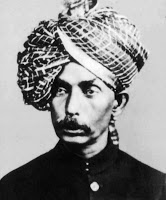 |
| ABDUL KAREEM KHAN |
Hirabai Barodekar was the second of the five surviving children of Ustad Abdul Kareem Khan, and his disciple, Tarabai Mane, who took on the Muslim name of Tahira Bibi upon her marriage to him. Hirabai (named Champakali at birth), along with her elder brother, Suresh Babu (named Abdul Rehman at birth), were initiated into music in early childhood. By the time Suresh Babu was 7 and Hirabai was barely 4, the proud father, Abdul Karim Khan began showing off their prodigious talent by making them perform short duet items at his own concerts in different parts of the country.
Hirabai’s early life in music was full of turmoil. According to some accounts, her father wanted to reorient his pubescent daughters towards a "respectable" life as householders rather than continue training in music. Hirabai circumvented this restriction by overhearing the training being given to his male disciples, especially her brother, Suresh Babu. Thereafter, while Hirabai was in her early teens, she had to face the consequences of parental discord. Her mother, Tarabai quit the Ustad's home, with their five children in tow, to start a new life in Bombay. To make a complete break from the past, she scrapped the family’s Muslim names, and adopted her maiden surname (Mane) for her sons, and Barodekar, the generalised description of the Maharashtrian community in Baroda, as the surname for the daughters.
It was an era of growing demand for music education, and music schools were coming up all over Maharashtra. In order to support the family, Tarabai opened a music school, where she and her eldest son, the 17-year old Suresh Babu were the main teachers. They also taught Hirabai. In addition, Hirabai was tutored, for short periods, by Mohammad Khan of the Agra gharana, and Ramkrishna Buwa Vaze, the Gwalior-trained original. But, Tarabai had to worry about giving her children the quality of training worthy of Abdul Kareem Khan’s lineage. The solution emerged through her friendly neighbors, Zohrabai and her daughter Munnibai, who were disciples of Ustad Abdul Waheed Khan, a kinsman and close associate of Abdul Kareem Khan. Zohrabai persuaded Abdul Waheed Khan to teach Suresh Babu and Hirabai.
Abdul Waheed Khan, though an affectionate father-figure to the promising teen-agers, was a tough taskmaster. His training was grueling, with each raga being taught for six months, with no concessions for boredom. Hirabai was a quick learner, and a hard-working disciple. The mentor himself acknowledged that Hirabai could master in a year what others would take four years to grasp.
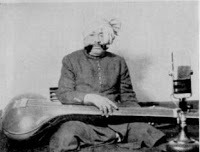 |
| ABDUL WAHEED KHAN |
In 1922, Vishnu Digambar Paluskar, the renaissance man of Hindustani music, invited Hirabai and Suresh Babu to perform at the annual day of the Gandharva Mahavidyalaya. The 17-year old Hirabai excelled and her performance and sent ripples of excitement through the music community at the arrival of a great new voice. Her mentor, Abdul Waheed Khan, took it badly as she had performed without his permission. Soon thereafter, Hirabai and Suresh Babu were invited to play roles as singer-actors in musical theatrical productions. Abdul Waheed Khan saw this direction as unbecoming of a high-brow lineage of musicians, and terminated the training of Hirabai and Suresh Babu. This was the year 1922, just about four years after they had commenced training with the Ustad.
In the profession
Starting from 1923, Hirabai began a hectic concert schedule, traveling widely with Suresh Babu as companion and Harmonium accompanist. In the same year, she launched her career as a recording artist which was to deliver almost 200 recordings to a hungry public over the next 45 years with the three major recording labels – HMV, Odeon, and Columbia. She continued to work sporadically in the regional theatre, while she traveled the lengths and breadth of the country charming audiences.
In 1924, Ustad Alladiya Khan of the Jaipur-Atrauli gharana organized a major musical event in Bombay, and invited Hirabai and Suresh Babu to perform. Once again, the two gave brilliant performances, obliging Alladiya Khan to pay handsome compliments to their talent and grooming. In 1937, Kesarbai Kerkar, the Empress of the concert platform, recommended Hirabai for invitation to the prestigious All India Music Conference in Calcutta, and took pride in introducing a new star. These endorsements added immensely to her reputation, and her concert career maintained its upward graph.
Lured by the buoyancy of the Marathi regional theatre, and her children’s talent for musical productions, Tarabai launched a drama company in 1929 as an adjunct to the music school she ran, so that all her children could be gainfully employed. Hirabai and Sureshbabu were assigned stellar roles. In this venture, Tarabai had the solid support of some of the finest musicians amongst theatre personalities of the times – Govindrao Tembe, Bal Gandharva, Master Krishnarao, Sawai Gandharva, and Vinayakrao Pathwardhan. The company produced three plays – Sanshay Kallol, Sangeet Saubhadra, and Sadhvi Mirabai. The plays featured superlative music, and were tremendously successful. But, the venture itself wall ill-fated.
Audiences started thinning as the era of talkies dawned. In 1933, the company downed shutters, with the family deeply in debt. Lawyers advised the declaration of insolvency and reneging on the debts. Hirabai refused, and took on the entire burden of debts pledging her professional earnings towards redemption. She swore thereafter never to work in the theatre.
That resolution was not easy to maintain. In 1944, ten years after she decided to quit theatre, her close friends and associates, Bal Gandharva and Master Krishnarao, persuaded her to revive her old play, Sangeet Saubhadra. The play was a thundering success, often starting at 10 pm and ending at dawn, with each song having to be sung several times on public demand. Thereafter, she accepted roles in Marathi films, and acted in three of them – Swarna Mandir, Pratibha, and Sant Janabai. Only the last one did well. After the failure of her films, she said goodbye, once and for all, to theatre and films.
In the mean while, in 1929, barely two years after the launch of the Indian Broadcasting Corporation (later, All India Radio), she began broadcasting her music. Through the “chain-booking” system of the broadcasting company, she performed on all stations in the country, from Kashmir to Calicut. Radio executives have lost count of her broadcasts over her 45-year broadcasting career; but do recall that her acceptance rate for radio bookings was close to 100%. In 1977, at the Golden Jubilee celebrations of All India Radio, Hirabai was honored by the Prime Minister of India as a stalwart broadcaster.
The stature, respect and affection Hirabai enjoyed amongst audiences and musicians alike was enviable. In 1946, the ultra-conservative Harballabh Sangeet Sammelan of Jallandhar, broke its 50-year convention of inviting only male musicians, and invited Hirabai to perform. At another prestigious music festival in Calcutta, KL Sehgal, the legendary singer-actor, interrupted her performance and walked up to the stage to present to her as many as 12 gold sovereigns gifted by members of the present audience in gratitude for her music. In 1947, when India gained independence, Hirabai was invited to broadcast the national song “Vande Mataram” at midnight of August 14-15.
For the better part of 45 years, until she put aside her Tanpura in 1973, Hirabai Barodekar was everywhere – on the concert platform, on gramophone records, on the radio, and in the regional theatre. Hers was one of the busiest careers amongst the musicians of her era. She lived with her travel kit ready at all times to respond to an invitation to perform anywhere in the country. She traveled willingly at short notice, by whatever means of travel was available, irrespective of discomfort, and remained indifferent to the level of hospitality she received from her hosts. Economics was, no doubt, the driving force. She was the bread-winner for a family of 25 dependents, including those of her siblings – especially after her brother, Suresh Babu died in 1952. She earned well, lived simply, redeemed the debts of her mother’s theatre company, remained a gracious hostess throughout her life, and had enough to retire in modest comfort.
Musicianship
Hirabai Barodekar’s repertoire covered five genres of music – Khayal, Thumree, Natya Sangeet, Bhava Geet and Bhajans. On rare occasions she also sang Ghazals. She was an unquestioned master of the Khayal and Natya Sangeet, though some of her Bhava Geet and Bhajans also became very popular. Almost two-thirds of her commercial recordings belong to the Khayal and Natya Sangeet genres. Her Thumree repertoire, too, had its admirers. Connoisseurs of her times, however, felt that, she did not have the temperament to do full justice to the seductive character of the genre. Her discerning contemporaries also believed that her involvement with the theatre did a lot of good to her competence as a classical vocalist. The acoustics of play houses in her times (devoid of amplification) trained her to throw her voice with a controlled consistency of timbre and volume – a great asset in the context of concert hall electronics. The demands of theatre music perhaps also helped her avoid the “more educative than entertaining” tag of her Guru, Abdul Wahid Khan.
Hirabai was aware that her formal training had been too short to justify her pedigree, and remained passionate about learning as much as she could from any obliging source. She routinely invited great musicians to perform at her residence, and learnt from them anything that caught her fancy. She had a close association with the scholar-musician, Vasantrao Deshpande, from whom she received guidance in classical music as well as Natya Sangeet. Through one of the wealthy patrons of that era, she became friends with the celebrated Thumree singer, Gohar Jan, and learnt several Purab style Thumrees and Ghazals from her. The legendary Natya Sangeet singer, Bal Gandharva, was her friend and colleague in the theatre. From him, she learnt many of the songs from his plays, and performed them widely in her own style.
Her classical repertoire was limited to the common and mature ragas preferred by Kairana gharana vocalists – ragas like Yaman, Bhoop, Shuddha Kalyan, Marwa, Malkauns, Multani, Basant, Miya Malhar, Todi and Bhairavi. When audiences requested her to sing a raga she did not know, she honestly admitted that she did not know it. It never bothered her that she did not have the esoteric repertoire that many vocalists of her era flaunted as hallmarks of musicianship. Under the most challenging conditions, she could melt the hearts of her audiences with what she knew.
Hirabai was a brilliant concert planner. She had an intuitive grasp of what repertoire would work with specific audiences. Unless placed under time constraints, she could hold audiences enthralled from 10 pm to 4 am, a common requirement of musicianship in her times. She could handle the occasional unpleasant surprises of the concert situation with great composure. At one festival in Calcutta, Hirabai’s cousin Roshanara Begum, scheduled to perform ahead of her, was in a nasty mood. Roshanara decided to wind up her own concert with Bhairavi, conventionally the last raga of an evening. Concert hosts were embarrassed by this affront to Hirabai’s stature by Roshanara. Hirabai was unperturbed. She went up to the stage, tuned her Tanpuras, and started raga Maru Bihag exactly as she had planned, and had the audience eating out of her hands in a few minutes.
Like Kesarbai amongst her seniors, Hirabai maintained a stable relationship with her accompanists. Her ensemble always consisted of Baburao Kumthekar on the Sarangi, Shamsuddin Khan on the Tabla and Rajabhau Koske on the Harmonium. The stability of these relationships contributed immensely to the rapport between the musicians, and to the harmonious and effortless delivery of music.
The most significant facet of Hirabai’s musicianship was her voice. In recent times, no other voice has inspired as much poetry and poetic prose as did Hirabai’s. Leading litterateurs of her times compared it to the soothing glow of the sky on a full-moon night. Hers was a voice soaked in honey, and yet crisp enough to enable the crystal clear execution of her musical ideas through two octaves. In the pitch-precision and intonation department, she was arguably the only female vocalist of the century who could hold a candle to the legendary perfection of her father, Abdul Kareem Khan. In addition to nature’s gift, her voice was a product of assiduous cultivation. No matter how late in the night she had retired, she never missed her pre-sunrise exercises for keeping the voice in fine fettle. She routinely practiced for four to five hours a day, irrespective of where she was.
Despite the diversity of her repertoire in terms of genres, her music in each genre was faithful to its esthetics. Her Khayals retained their formal aloofness, and were never in danger of becoming Thumrees. Nor did they ever drift towards the more entertaining stylistics of Natya Sangeet. Despite the variety of influences on her style, Hirabai’s Khayals were her own, and yet bore the unmistakable stamp of melody-dominant Kairana vocalism. Hers was disciplined music, but without the academism of Abdul Waheed Khan. Hers was intelligent music, without ever becoming a display of either cleverness or scholarship. Her intellect was deployed, instead, towards refining the aesthetic sensibility that guided her music. Her music thus acquired a universal appeal, appreciated by the laity as well as connoisseurs.
Even her admirers admitted that her music lacked daring experimentalism and the element of surprise evident in the vocalism of, say, Kesarbai Kerkar. Hirabai’s music was a reflection of her personality, which was essentially conservative, mellow, warm and affectionate. Her father’s music was steeped in Karuna Rasa (the sentiment of pathos). Her Guru, Abdul Waheed Khan’s music was very cerebral. Hirabai’s musical personality belonged to the territory of Shanta Rasa (the sentiment of peace and tranquility) and Vatsalya Rasa (the maternal sentiment).
The architecture of her Khayal presentations was flawless, corresponding to the two-tier Kairana structure with an alap followed by tan-s. Her alap was amongst most celebrated alaps of her era. She constructed it like an exquisite string of pearls, carefully evaluating every phrase for its beauty, and stringing it meticulously to create a well-knit melodic experience. The most widely admired facet of her alap was her ascent to the upper-Sa in the antara. The ascent was so astutely constructed that, the reposeful arrival at the upper-Sa became an ecstatic experience. Amongst her seniors of the era, Kesarbai’s antara-s were equally valued. But, there was a difference. Kesarbai made the audiences’ jaws drop in marvel. Hirabai’s anatara-s, instead, penetrated their consciousness, and sent them into a trance. Hirabai’s virtuosity in the tan-s department was no inferior to that of her major contemporaries. But, unlike them, she constructed and rendered them with simplicity and warmth that were innate to her personality, rather than to intimidate.
Despite her classicism, and the passage of time, Hirabai's music shows no signs of aesthetic obsolescence and retains its appeal to this day. One of the tragedies for later generations of music lovers is that very little of her music has been published on concert-length media, and very few of her concert recordings are in circulation amongst archivists. The most inexplicable aspect of this reality is that All India Radio, the holder of the largest Hirabai archive spread over her entire performing career, has ignored her in its programme for the commercial release of their musical assets.
(c) Deepak S. Raja 2011
Saturday, 1 December 2018
R.V. Jadhav (1885−1964) - Gharana - Kirana - Cassette released in India in 1999
Here some beautiful recordings by a direct disciple of Ustad Abdul Karim Khan. With these recordings one has perhaps an impression how longer performances of Ustad Abdul Karim Khan might have sounded. See also the remarks at our post of an LP by Yeshwantrai Purohit (1916-1964).
On the artist, also known as Vishwanath Jadhav, see:
Subscribe to:
Posts (Atom)
